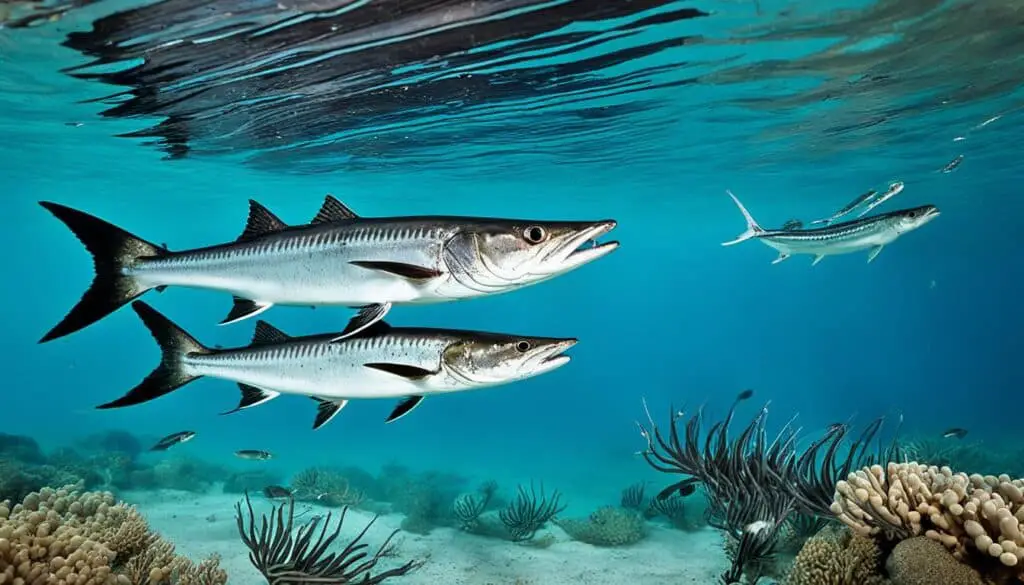Barracuda reproduction is a fascinating process that shows how these fish are vital to the ocean’s balance. Learning about how Great Barracudas reproduce helps us understand their breeding habits and the hurdles they face. We’ll dive into the details of their reproduction and what affects their spawning.
Understanding Barracuda Reproduction
Barracuda reproduction is fascinating in marine biology. It shows how different barracuda species adapt and survive. These fish are key to coastal ecosystems. Their breeding habits tell us about their survival and how they adapt.
Overview of Barracuda Species
The Sphyraenidae family includes many barracuda species, with the Great Barracuda being the most well-known. These fish live in tropical and subtropical oceans, often near coral reefs and in estuaries. These places are vital for their reproduction, offering food and protection for young fish.
Their behavior in these areas has changed a lot, affecting how they spawn.
Key Characteristics of the Great Barracuda (Sphyraena barracuda)
The Great Barracuda stands out with its unique features. They weigh between 10 kg to 40 kg and can reach up to 2 meters long. They have an elongated body, a big mouth with sharp teeth, and a forked tail.
Young ones are green-brown, but turn silvery as they grow. Knowing these traits helps us understand where they live and how they reproduce.
How do barracudas reproduce?
Barracudas have a unique way of reproducing that includes external fertilization and special spawning behaviors. These methods help them keep their species going.
External Fertilization Process
The way barracudas fertilize their eggs is quite interesting. When it’s time to spawn, the female releases eggs into the water. At the same time, the male adds sperm. This teamwork increases the chances of fertilization.
After fertilization, the eggs move towards estuaries. These areas are safer for the eggs to grow.
Spawning Behavior and Timing
Watching barracudas mate is hard because they do it in secret. They usually spawn in the ocean during spring and summer. The moon’s phases might affect when they spawn, making their timing change.
Female barracudas can lay up to 300,000 eggs at once. This shows how many offspring they can have.

| Spawning Season | Estimated Eggs Released | Possible Influencing Factors |
|---|---|---|
| Spring | 5,000 – 300,000 | Lunar phase, Water temperature |
| Summer | 5,000 – 300,000 | Lunar phase, Water temperature |
Barracuda Breeding Habits and Spawning Locations
The breeding habits of barracudas are shaped by many environmental factors. These factors help them succeed in reproducing. Knowing where and how they prefer to spawn gives us clues about their life cycle and behavior.
Preferred Environmental Conditions
Great Barracudas do best in certain environmental conditions for breeding. They need warm water, between 74°F and 82°F, to spawn successfully. They live in shallow coastal areas like estuaries and mangroves. These places offer them safety from predators and plenty of food.
These habitats are key for young barracudas to grow and develop. It shows how important the right environment is for their early life.
Seasonal Patterns of Spawning
When and where barracudas spawn changes with the seasons. They usually have their young between April and September. This time is crucial for their life cycle.
Knowing when they spawn helps us understand how changes in the environment might affect their numbers.
Barracuda Life Cycle: From Eggs to Adult Fish
The barracuda life cycle starts with the delicate process of egg development. After spawning, the eggs float on the water’s surface. Currents help spread them out. During this time, the young barracudas must find safe places to live.
They move to places like mangroves and shallow waters to avoid predators. This helps them grow and survive.
Egg Development and Survivability
Barracuda larvae face many challenges early on. The eggs are exposed to different environmental factors that can affect their survival. But when they hatch and move to safer places, they have a better chance against predators.
This early growth phase shows how important it is to choose the right habitat. It helps the barracuda population stay healthy and sustainable.
Juvenile Habitat and Growth Phases
When juvenile barracudas reach about 6 cm, they start moving into open waters. This is a key step in their growth. It helps them find more food and avoid big predators.
During their juvenile stage, they live in different habitats. This is vital for their development. Later, they move to deeper waters to live as adults.
FAQ
How do barracudas reproduce?
Barracudas reproduce through a process called external fertilization. Females release eggs into the water. At the same time, males release sperm. This method increases the chance of fertilization as the eggs drift away in the currents.
What are the preferred spawning locations for barracudas?
Great Barracudas prefer shallow coastal regions. They like estuaries and mangroves. These places provide protection for the eggs and young fish from predators.
What is the spawning behavior of barracudas?
Barracudas spawn in offshore waters during spring and summer. The timing depends on temperature and lunar phases. A single female can release between 5,000 to 300,000 eggs during spawning.
During which months do barracudas spawn?
Barracudas usually spawn between April and September. They do this in warmer water temperatures that help their reproduction.
What happens to barracuda eggs after fertilization?
After fertilization, the eggs float on the water’s surface and currents spread them. They stay vulnerable until they hatch. Then, the larvae look for safer places like mangroves.
How do juvenile barracudas grow and develop?
At first, young barracudas live in safe places until they grow to about 6 cm. Then, they move to open waters. This helps them avoid predators and find food. Eventually, they move to deeper waters as adults.
What challenges do barracudas face during reproduction?
Barracudas face many challenges during reproduction. These include predators eating their eggs and young, losing their homes, and changes in their environment. These can all affect how well they can reproduce.
Source Links
- https://www.lamar.edu/arts-sciences/biology/study-abroad-belize/marine-critters/marine-critters-2/the-great-barracuda.html
- https://sta.uwi.edu/fst/lifesciences/sites/default/files/lifesciences/documents/ogatt/Sphyraena_barracuda – Great Barracuda.pdf
- https://animaldiversity.org/accounts/Sphyraena_barracuda/







